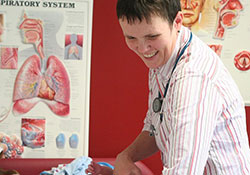Dr Katrin Martinson is a general practioner working in Tallinn, Estonia

© World Health Organization
“I am one of five female doctors in the clinic, and we are responsible for approximately 8000 patients. I was trained at Tartu University in Estonia, and have lived and worked in my home country for most of my life. There is a huge shortage of young doctors in this country; many of them have chosen to complete their studies in Finland or Sweden, where better practical training is available. Once qualified, they frequently choose to stay and work in the host country, where they find salaries are approximately four times higher than at home. This creates a big problem for the health system, as family doctors are currently working to the limit, and replacement doctors are a scarce commodity. However, Estonia has worked hard to develop a good primary care system, and these efforts are starting to show results. On the whole, people are satisfied with the primary medical care they receive in this country.
The majority of family practitioners in Estonia are female – out of 263 family doctors in the Tallinn Family Doctors Society, only 17 are men. Men are not interested in family medicine; they can earn more money as specialists in hospitals. This greatly impacts the work of female family doctors, who find it difficult to take family time or indeed have babies of their own, as it creates an additional load on colleagues in their teams.
Estonia is a forerunner in Internet technology, and our clinic has its own web site, where patients can write requesting appointments or advice from their doctors. However, people prefer face-to-face consultations and I really value the close relationship with patients. I see approximately 20 patients daily, and have one hour in my schedule to take calls and give advice over the phone. I know all of my patients personally, and taking care of the whole family from birth makes diagnosis and treatment easier, as I have the complete history.”


